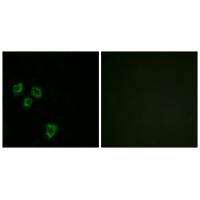![IHC-P analysis of human ovarian carcinoma tissue using GTX20697 CA125 antibody [OV185:1]. IHC-P analysis of human ovarian carcinoma tissue using GTX20697 CA125 antibody [OV185:1].](https://www.genetex.com/upload/website/prouct_img/normal/GTX20697/GTX20697_20191203_IHC-P_41_w_23060620_768.webp)
IHC-P analysis of human ovarian carcinoma tissue using GTX20697 CA125 antibody [OV185:1].
CA125 antibody [OV185:1]
GTX20697
ApplicationsWestern Blot, ImmunoHistoChemistry, ImmunoHistoChemistry Paraffin
Product group Antibodies
ReactivityHuman, Rat
TargetMUC16
Overview
- SupplierGeneTex
- Product NameCA125 antibody [OV185:1]
- Delivery Days Customer9
- Application Supplier NoteIHC-P: 1:25-1:50. *Optimal dilutions/concentrations should be determined by the researcher.Not tested in other applications.
- ApplicationsWestern Blot, ImmunoHistoChemistry, ImmunoHistoChemistry Paraffin
- CertificationResearch Use Only
- ClonalityMonoclonal
- Clone IDOV185:1
- ConjugateUnconjugated
- Gene ID94025
- Target nameMUC16
- Target descriptionmucin 16, cell surface associated
- Target synonymsCA125, mucin-16, CA125 ovarian cancer antigen, cancer antigen 125, ovarian cancer-related tumor marker CA125, ovarian carcinoma antigen CA125
- HostMouse
- IsotypeIgG1
- Protein IDQ8WXI7
- Protein NameMucin-16
- Scientific DescriptionThis gene encodes a protein that is a member of the mucin family. Mucins are high molecular weight, O-glycosylated proteins that play an important role in forming a protective mucous barrier, and are found on the apical surfaces of the epithelia. The encoded protein is a membrane-tethered mucin that contains an extracellular domain at its amino terminus, a large tandem repeat domain, and a transmembrane domain with a short cytoplasmic domain. The amino terminus is highly glycosylated, while the repeat region contains 156 amino acid repeats unit that are rich in serines, threonines, and prolines. Interspersed within the repeats are Sea urchin sperm protein Enterokinase and Agrin (SEA) modules, leucine-rich repeats and ankyrin (ANK) repeats. These regions together form the ectodomain, and there is a potential cleavage site found near an SEA module close to the transmembrane domain. This protein is thought to play a role in forming a barrier, protecting epithelial cells from pathogens. Products of this gene have been used as a marker for different cancers, with higher expression levels associated with poorer outcomes. [provided by RefSeq, May 2017]
- ReactivityHuman, Rat
- Storage Instruction2°C to 8°C
- UNSPSC12352203
References
- Tchedre K, Imayasu M, Hori Y, et al. Contact lens care solutions downregulate membrane-associated mucins 1 and 16 in cultured human corneal epithelial cells and at the rat corneal surface in vivo. Eye Contact Lens. 2013,39(6):394-9. doi: 10.1097/ICL.0b013e3182a2f8d9Read this paper
- Tchedre KT, Imayasu M, Hori Y, et al. Assessment of effects of multipurpose contact lens care solutions on human corneal epithelial cells. Eye Contact Lens. 2011,37(5):328-30. doi: 10.1097/ICL.0b013e31822c36c2Read this paper





